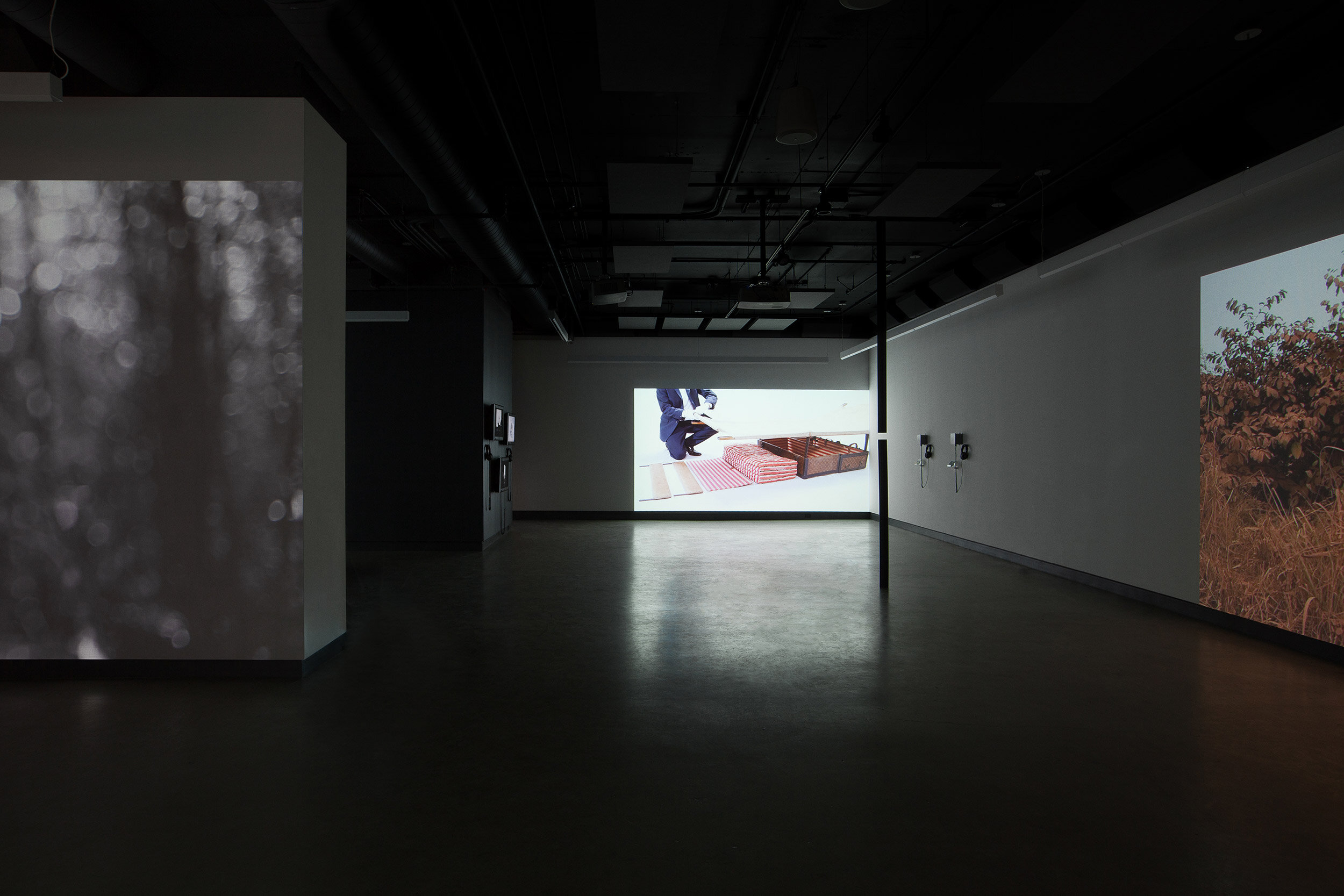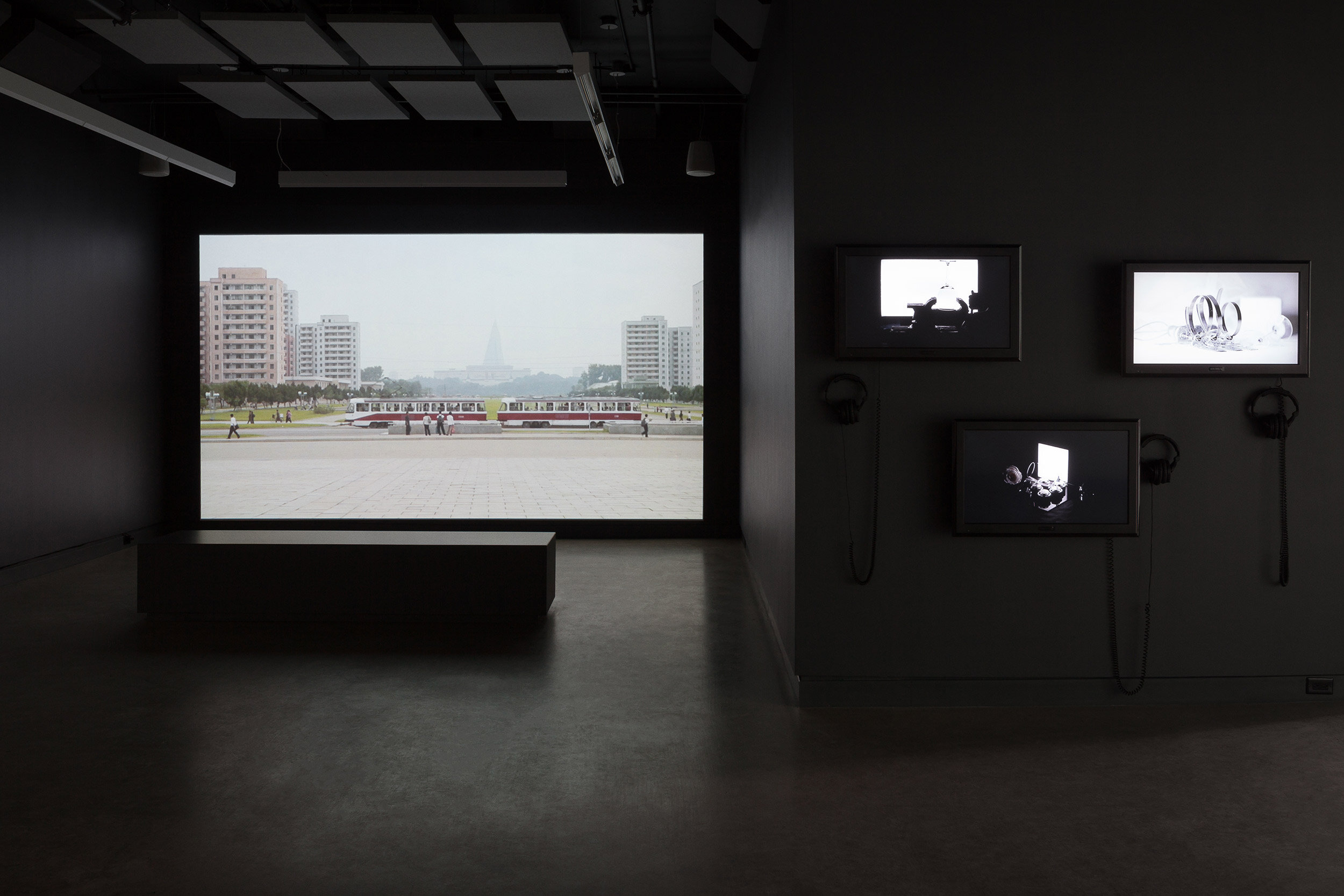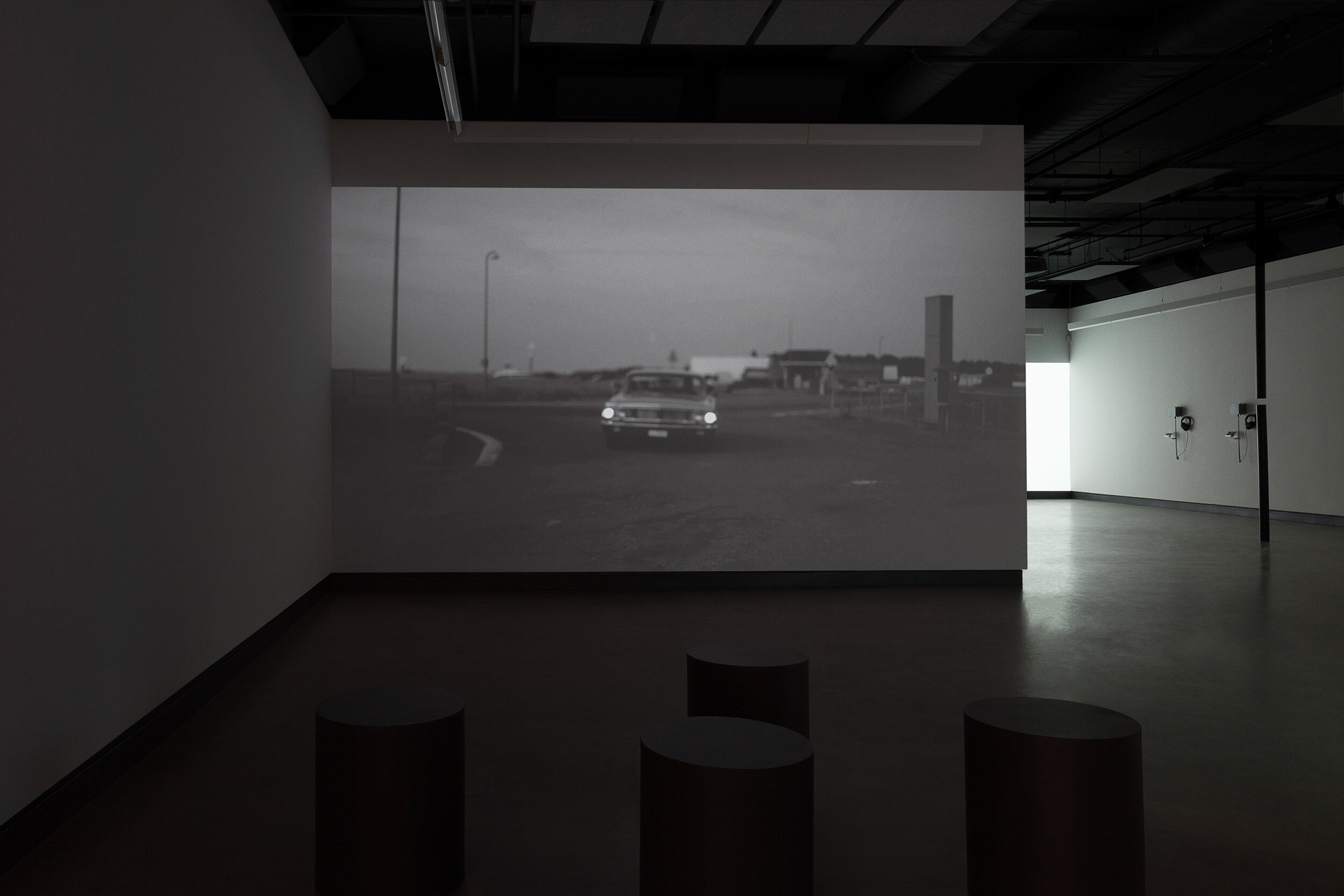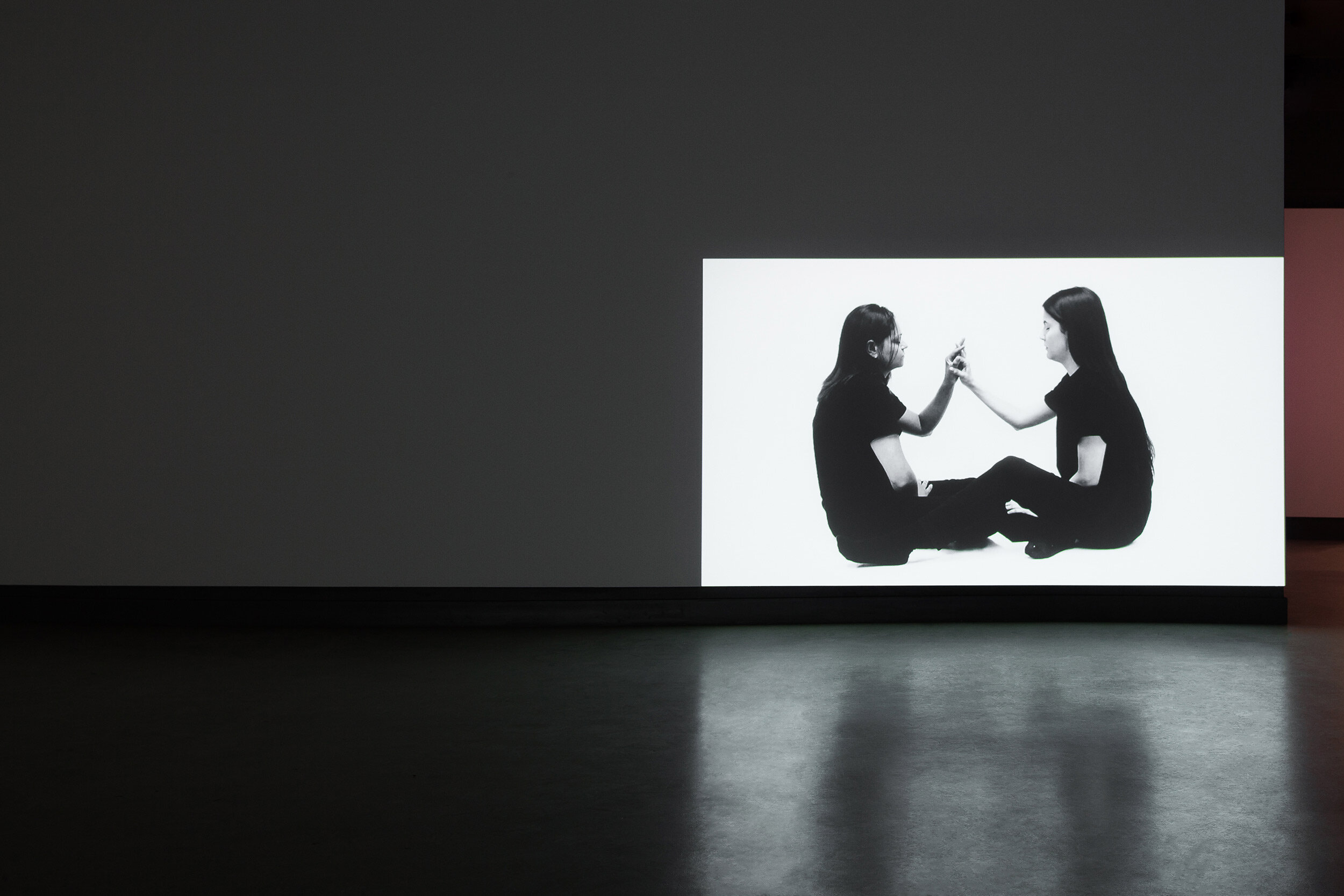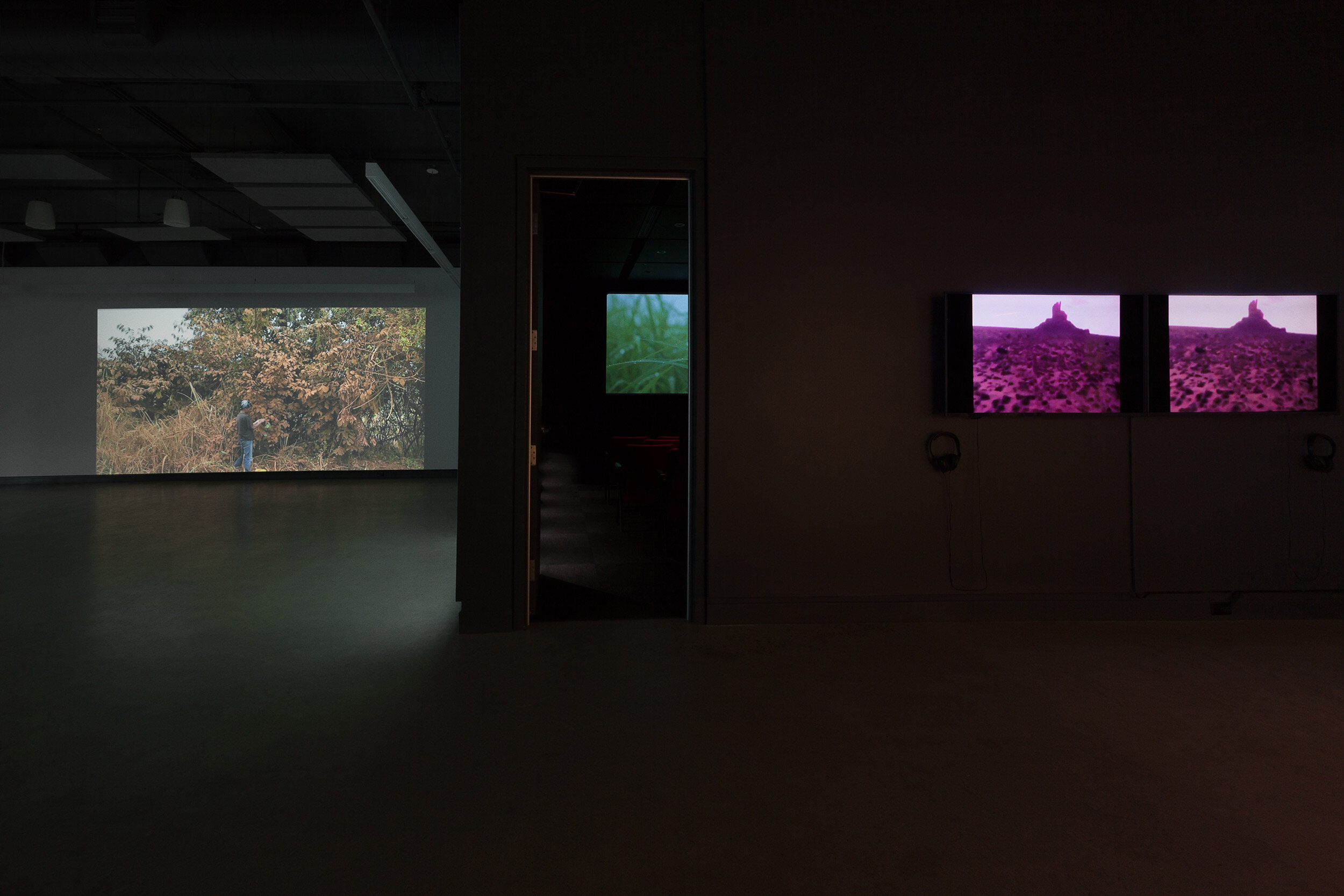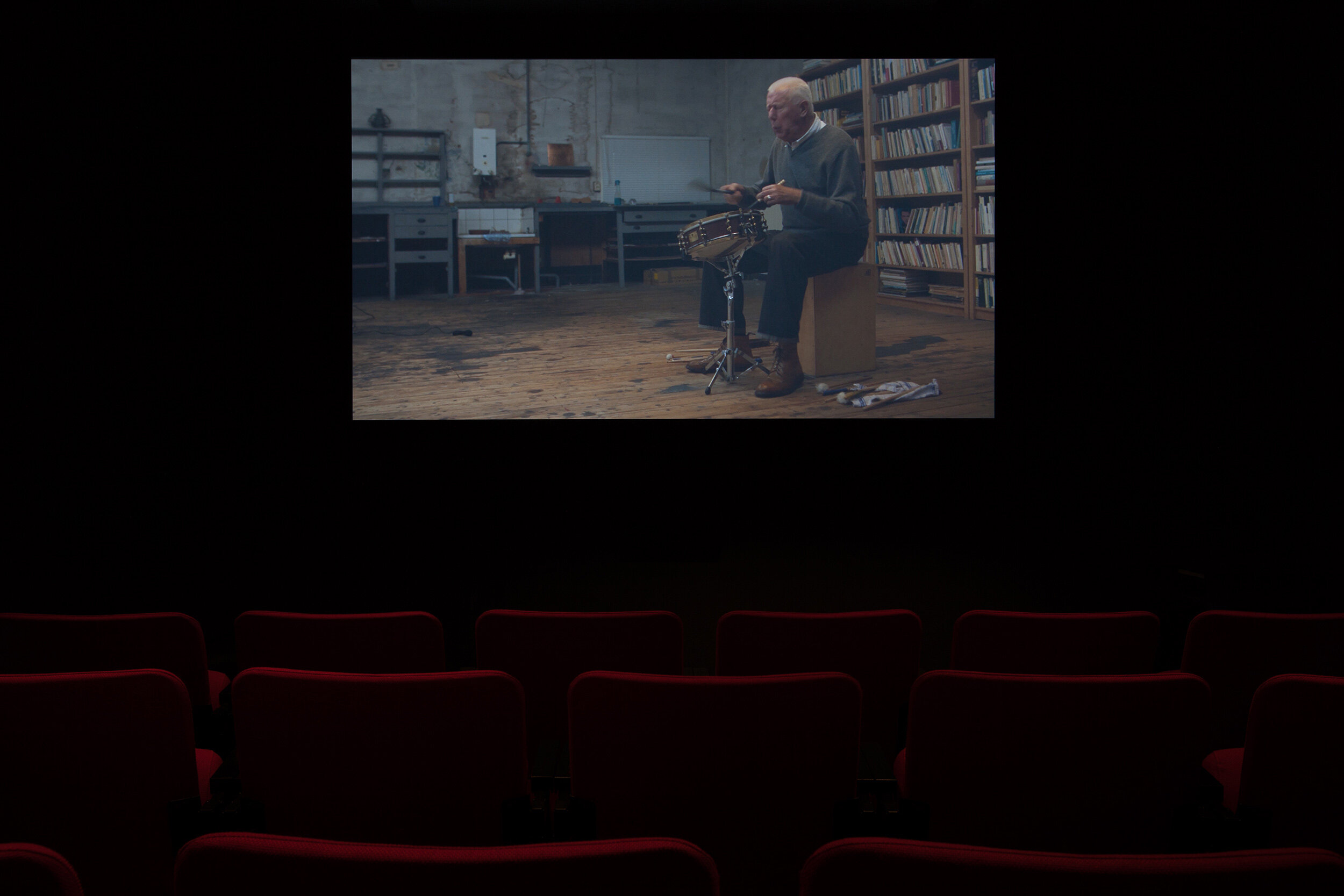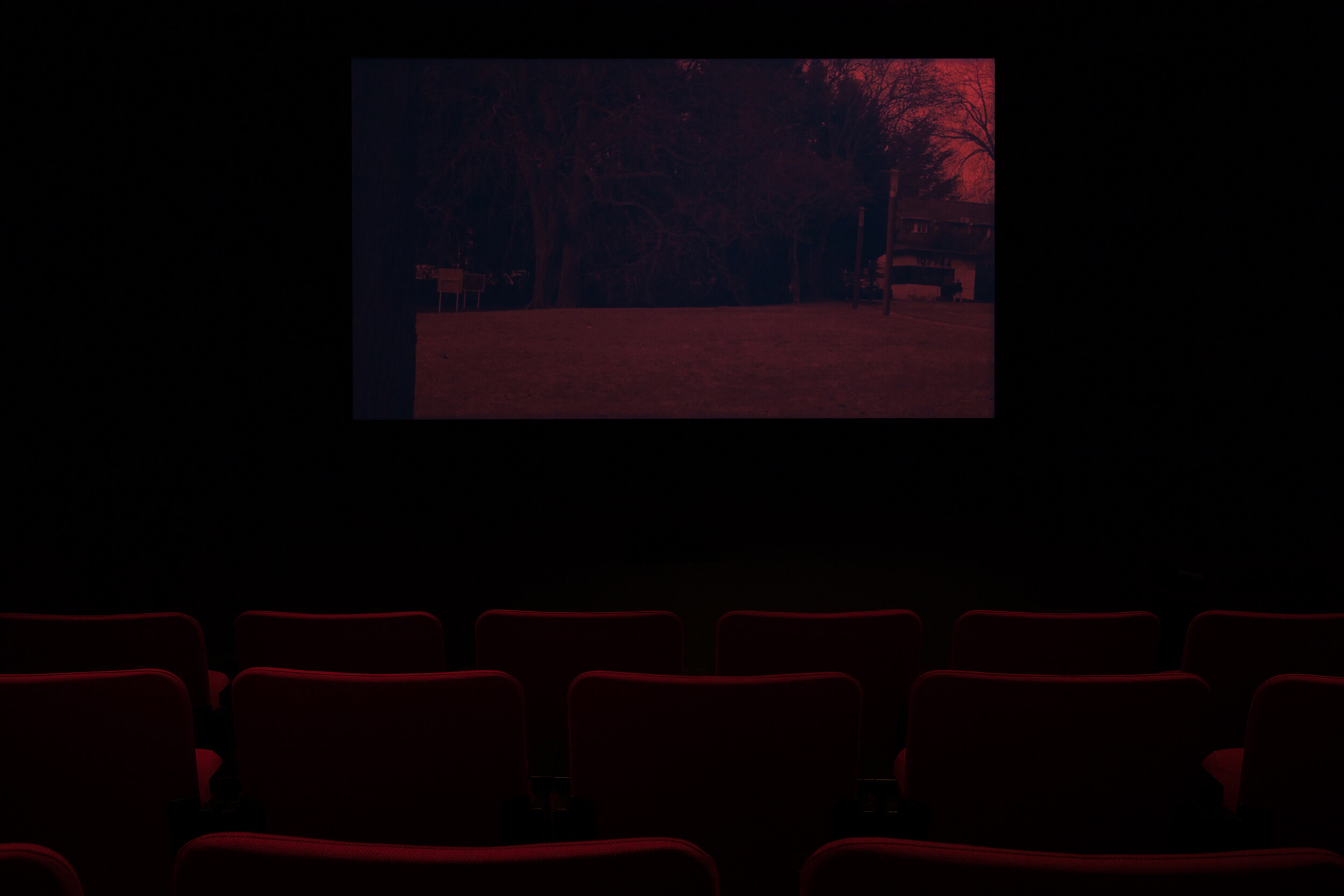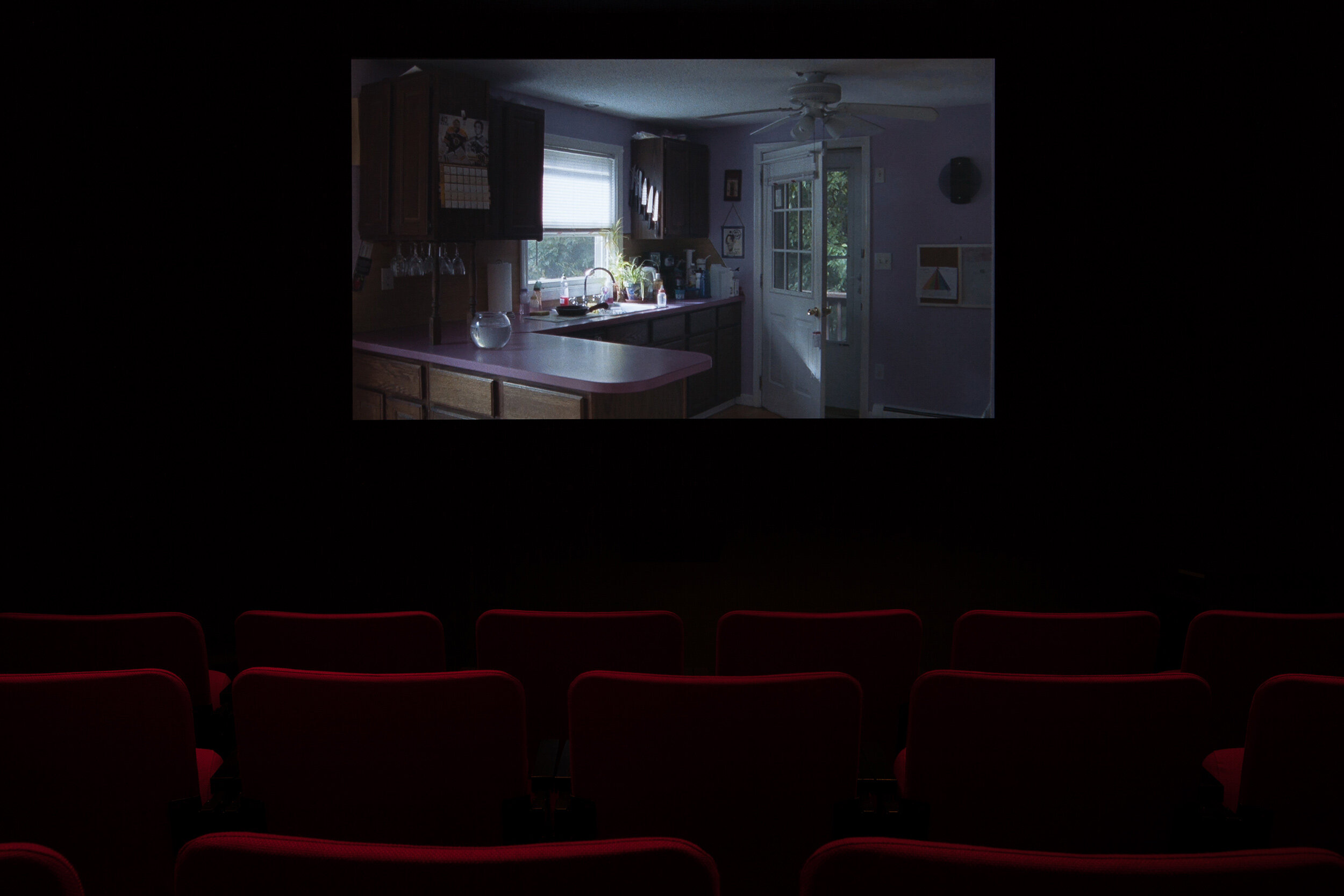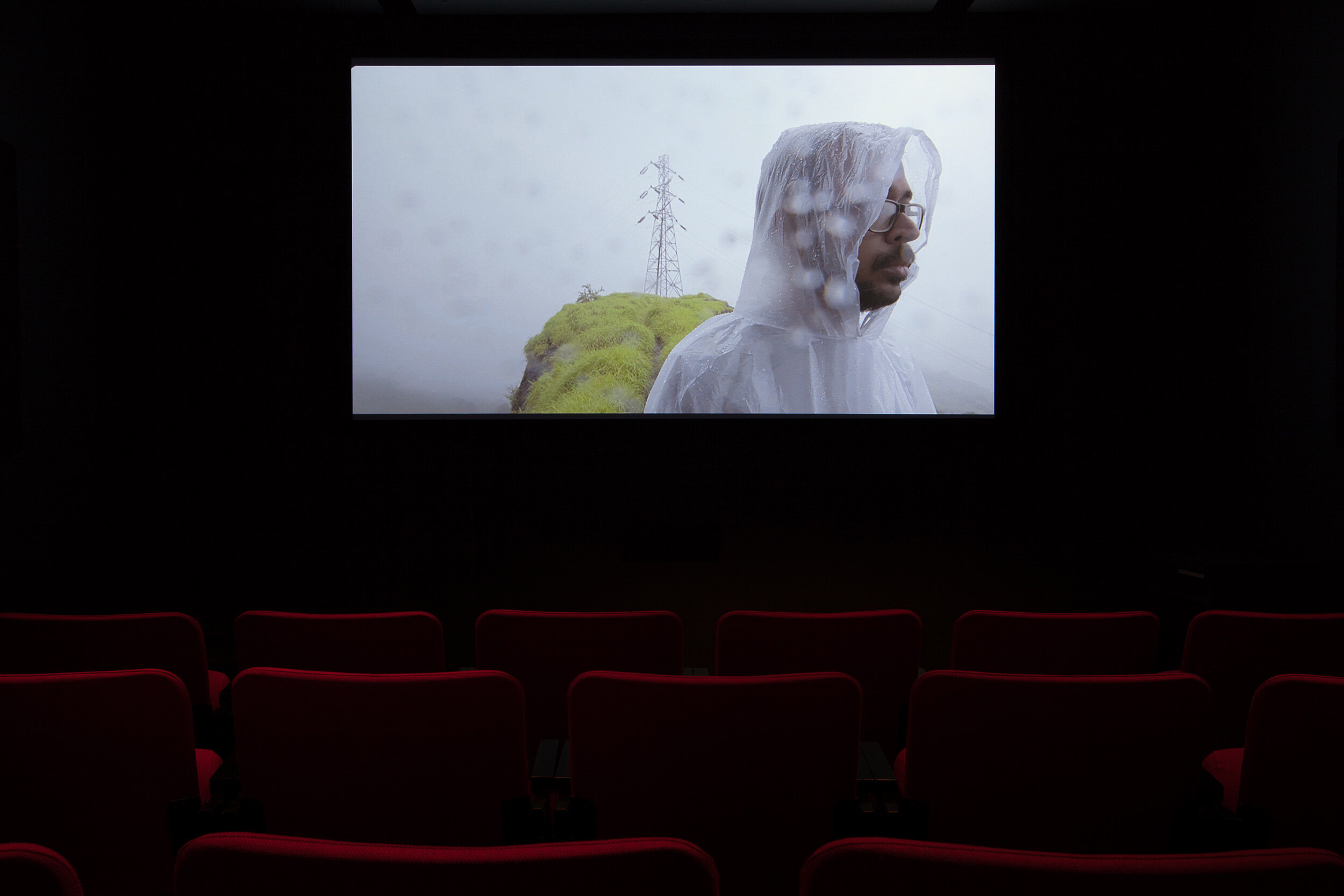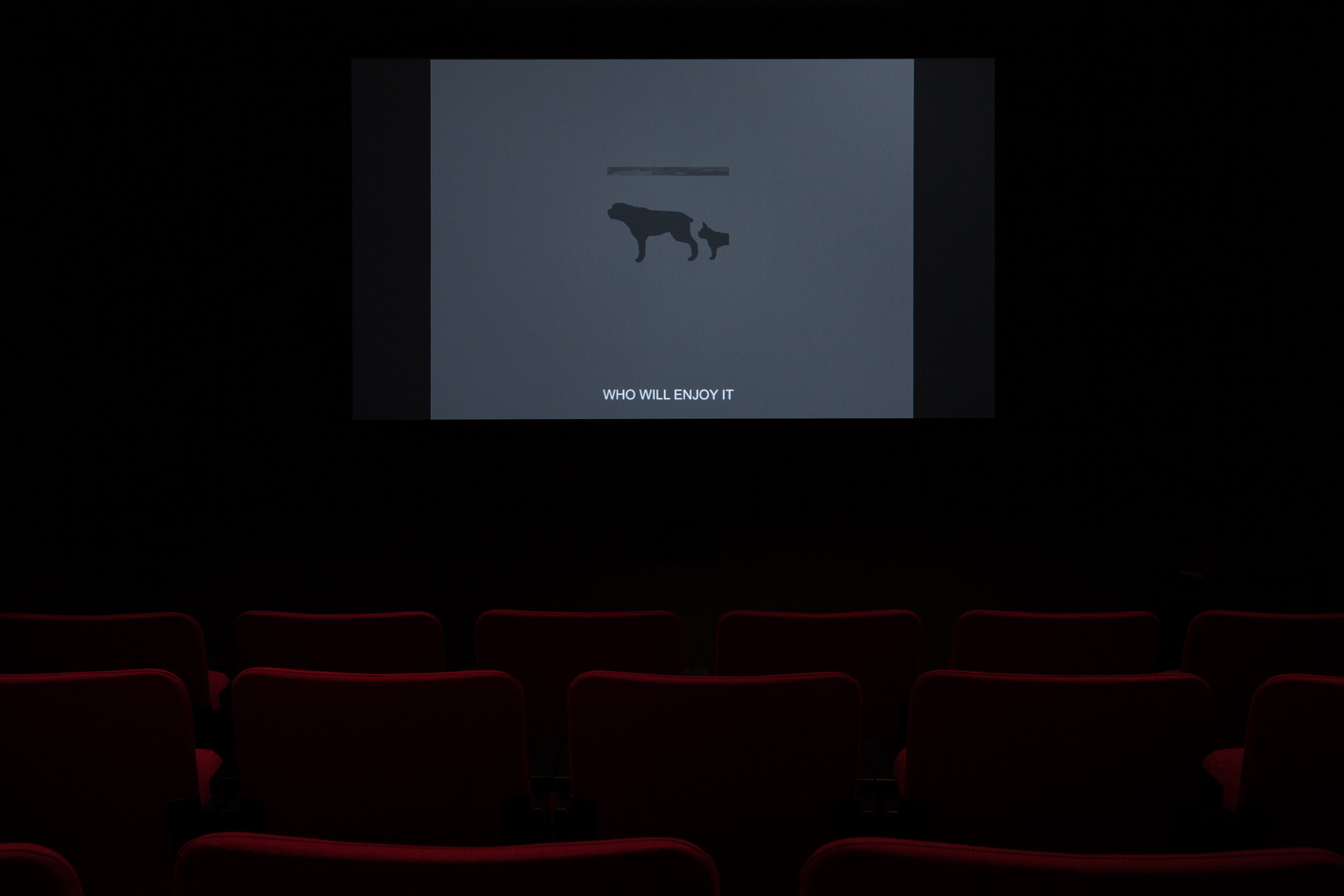Entends-tu ce que je vois?
Do You See What I Hear?
From March 29 to June 2, 2018
Opening on March 29 at 7 pm
+ performance by Rosalie Jean at 8 pm
Wojciech Bąkowski, Bianca Baldi, Simon M. Benedict, Mareike Bernien & Kerstin Schroedinger, Myriam Bleau, Bojan Fajfrić, Miriam Gossing & Lina Sieckmann, Rosalie Jean, Kapwani Kiwanga, Douglas Moffat, Naveen Padmanabha, Jen Reimer & Max Stein, Sofie Thorsen and Marie Voignier.
An exhibition prepared for Dazibao by France Choinière.
Images so that we may hear; sounds so that we may see. A willingness to refine our understanding of the world, to extract from the unique relationship of sound and image a meaning that transcends our initial perception of the whole. As though the incompleteness brought forth by the absence, censorship or obliteration of one sense contributes to the making of sense. As though the essence of the matter resides in unfulfilled expectations, or in the avowed lacunae of several of the artworks brought together here.
Watch, listen more closely to catalyze a sharper form of consciousness and an enduring acuity that permit an ever-clearer reading of things and of this world, which, for the first time in history, is called upon to face its precariousness through an incessantly mediated reality.
1 — Simon M. Benedict (Toronto, Canada)
Simon M. Benedict is a Toronto-based artist working with video, sound and performance. His video works repurpose audiovisual material ranging from YouTube videos to feature films to explore our relationship to various forms of fiction and its impact on our perception of reality. In 2011, he obtained a BFA in Photography from Concordia University (Montréal, Canada), and went on to complete an MFA at the University of Guelph (Ontario, Canada) in 2016. His work has been shown in numerous exhibitions in Canada, the United States, and Europe, including four solo exhibitions: painter project at VU PHOTO (Québec, Canada) and at TYPOLOGY (Toronto, Canada), BLIP* at Noble Space (Toronto) and The Complete Dare Videos at Pierre-François Ouellette art contemporain (Montréal). He has been artist-in-residence at the National Film Board of Canada (Montréal), Artscape Gibraltar Point (Toronto), the Banff Centre (Alberta, Canada) and Centre des arts actuels Skol (Montréal).
blips (2017) is part of a series of video works that consider the possible parallels between space exploration and colonialism. The project uses as its premise material from the "Golden Record," which was launched into space aboard the Voyager 1 and Voyager 2 spacecrafts in 1977 with hopes that extraterrestrials would one day find it. The records contained images, sound recordings and music meant to provide information about Earth’s diverse cultures and life forms. Combining footage from American Airlines advertisements from the 1960s and reinterpretations of sounds from the Golden Record, the dreamlike videos that comprise blips embody a certain confidence or power, suggesting that the desire to explore space and to make ourselves known to an extraterrestrial "Other" renews and repeats colonial motivations.
Sound ― variable duration
2 — Sofie Thorsen (Vienna, Austria)
Through sculpture, collage, painting, architectural drawing, photography and film, Sofie Thorsen questions the ways in which space and architecture are perceived, focusing on the social, cultural, historical and political implications of such perceptions. Born in Aarhus (Denmark), she currently lives and works in Vienna (Austria). She holds degrees from the Hungarian University of Fine Arts in Budapest, the Royal Danish Academy of Fine Arts in Copenhagen and the Academy of Fine Arts Vienna, where she taught until 2009. Her work has been widely exhibited in Europe and in the United States, notably at the MAK in the context of the Vienna Biennale, Petra Gut Contemporary (Zurich, Switzerland), Den Frie Centre of Contemporary Art (Copenhagen) and the DOX Centre for Contemporary Art (Prague, Czech Republic). Her recent solo shows include View, Cut at mumok (Vienna), Whose Sleeves? at Galerie Anhava (Helsinki, Finland) and Some Lines at Center for Energiadministration (Esbjerg, Denmark). She is the recipient of many awards, and in 2016 she received sponsorship from the Danish Arts Foundation in the context of the ISCP International Program (New York, USA).
The Achromatic Island (2009-10) observes the landscape of the Danish Island of Fur as seen through the eyes of an achromat. Achromatopsia is a hereditary strain of black-and-white colour blindness caused by a lack of photoreceptors in the eyes, which normally allow for the differentiation between wavelength and intensity, ensuring the perception of colour. Prior to the Island of Fur's opening itself gradually to outsiders in the 1930s, the condition was common among the mere one thousand inhabitants of this small and isolated community. In 2009, Thorsen met with the last of those born on the island with the condition. In a series of interviews, they explain exactly what they are able to see. Several excerpts of their accounts are compiled into the narration of the film, while the accompanying images attempt to reproduce their descriptions. Dizzying, diffuse and lacking depth, The Achromatic Island seeks to recreate their world. The ability to do so, however, is curbed by our fundamental inability to fully grasp the perception of others – especially when so radically different from our own. Through documenting the peculiarities of a place and its community, the film offers an acute observation of the limits of art and language.
3 — Rosalie Jean (Montréal, Canada)
The performances and videos of Rosalie Jean investigate alternative forms of communication made possible through heightened availabilities of sensory reception. Placing the body at the centre of her works, she explores the tensions produced and possibilities offered by corporeal limits within the sphere of communication. Jean lives in Montréal (Canada) and is currently finishing a Masters in Visual and Media Arts at the Université du Québec à Montréal, where she also completed a Bachelor of Fine Arts in 2016. Her work has been included in several exhibitions and performance events in Montréal. She is the recipient of the Irène-Senécal Prize for excellence and has presented her work within the context of several university conferences, notably Interventions dans l’environnement : Petites tailles, grands impacts.
Tête-à-tête (2017) presents two women sitting face-to-face. In near-perfect symmetry, one becomes the other’s reflection. Clad entirely in black, the women are in stark contrast to the white environment that surrounds them. Eyes closed, they perform gentle gestures in the palms of the other’s hands. In complete silence, they communicate by means of tactile signing, a form of sign language used by those who are both deaf and blind, in which words are spelled through touch. Their facial expressions - whether they are smiling, nodding, or frowning — indicate their understanding of what the other is trying to say. Patience and empathy are at the core of the work, underscoring the body’s interminable ability to communicate with others.
4 — Kapwani Kiwanga (Paris, France)
Kapwani Kiwanga’s performances, sound pieces, installations, and videos use an anthropological approach to explore anti-colonial struggles, afrofuturism, and marginalized discourses. Born in Hamilton (Ontario, Canada), Kiwanga currently lives and works in Paris (France). She holds a dual Bachelor’s Degree in Anthropology and Comparative Religions from McGill University (Montréal, Canada) and also studied at the École nationale supérieure des Beaux-Arts de Paris, taking part in the research program “La Seine.” Her recent solo shows include The sum and its parts at the Logan Center (Chicago, USA), A wall is just a wallat The Power Plant Contemporary Art Gallery (Toronto, Canada) and Afrogalactica at the Fondazione Sandretto Re Rebaudengo (Turin, Italy). Her work has also been included in several group shows, notably at the Irish Museum of Modern Art (Dublin, Ireland), the Glasgow Center for Contemporary Arts (Scotland), the Hammer Museum (Los Angeles, USA) and Centre Pompidou (Paris). She was artist-in-residence at Artpace in San Antonio (Texas, USA) in 2018, and at Galerie le Manège - Institut français (Dakar, Senegal) in 2013. She is the recipient of many awards and has twice been nominated for a BAFTA. She is the 2018 winner of the Frieze Artist Award (New York, USA).
Vumbi (2012) is set in rural Tanzania and uses the Swahili word for “dust” as its title. During the dry season, a layer of red dust coats the terrain, turning the landscape monochromatic. In a gesture reminiscent of subtractive painting, Kiwanga dusts the leaves that have been coated, revealing the hidden colours underneath. A green line, sharply contrasting the red landscape, is formed in the foliage. This act of dusting, however, is in vain, as the leaves will inevitably soon be covered once again with red dust.
5 — Douglas Moffat (Montréal, Canada)
Douglas Moffat constructs environments for listening, using field recordings, electroacoustic music, and landscape architecture. Moffat received a Bachelor's of Landscape Architecture from the University of Guelph (Ontario, Canada) in 1999, a Master's of Fine Arts in Sculpture from Concordia University (Montréal, Canada) in 2009, and a Post-Professional Master's of Architecture from McGill University (Montréal) in 2010. His recent project Listening to Las Vegas explores the sonic environment of the city's principal artery, commonly known as "The Strip". His work has been presented in the context of The International Garden Festival at the Jardins the Métis (Québec, Canada) and the send + receive Festival (Winnipeg, Canada). For two summers, he has co-led workshops at the Architectural Association School of Architecture (London, UK). In collaboration with Steve Bates, he recently completed OKTA, a major public sound installation for the City of Toronto. He lives and works in Montréal.
Valsalva Manœuvre / Corridor Pressure (2018) is inspired by the experience of sound in extreme environments. The Valsalva manœuver is used by scuba divers to regulate pressure as they descend into deep water. To perform the maneuver, they close their nasal passages and force the pressure out of their ears momentarily, which causes the internal sounds of the body to rush in and external sounds to be drowned out. For this project, Moffat has created an installation that draws a similar attention to sound and pressure. The viewer finds themselves in a gap between two pipes, each mounted with a speaker to create an acoustic atmosphere similar to that within a diver’s helmet, or empty corridor. The spectator is invited to listen actively and consider sound’s relativity to time and space.
6 — Jen Reimer & Max Stein (Montréal, Canada)
Working in collaboration since 2009, Jen Reimer and Max Stein are sound artists and performers based in Montréal (Canada). They create immersive experiences using spatial recordings, electroacoustic compositions, online mapping and site-specific performances. Their work has been presented in Montréal at Suoni per Il Popolo, HTMlles and Pop Montréal, and internationally at Sound Development City (Lisbon, Portugal and Marseille, France), Lisboa Soa (Lisbon), Äänen Lumo (Helsinki, Finland), Les Digitales (Lausanne, Switzerland), Art in Odd Places (New York, USA), Video Sound Art Festival (Milan, Italy) and Path Festival (Verona, Italy). In 2016, they launched Sounding the City, their first online exhibition, featuring maps and photos of site-specific installations and acoustic interventions in Montréal.
Mounted to the gallery wall, Sounding the City (2015-16) resembles a series of electricity boxes; similar to those often found on the side of a building or electrical pole. The viewer is invited to listen to soundscape compositions that are paired with maps to the spaces where the recordings were made. Although situated in the gallery, the work extends beyond the walls and invites the viewer to its place of origin. The installation proposes sound as portraiture.
7 — Bianca Baldi (Johannesburg, South Africa)
In her films, installations, photographs and written texts, Bianca Baldi addresses hidden power structures and narratives of oppression. Evoking the histories of film, studio photography and trompe-l'œil, she positions carefully chosen objects within a discourse of teleology. Born in Johannesburg (South Africa), Baldi obtained a Bachelor of Arts in 2007 from the Michaelis School of Fine Art (Cape Town, South Africa) and recently completed her studies at the Städelschule (Frankfurt, Germany). She lives and works in Brussels (Belgium). Her work has been featured in exhibitions such as the 11th Shanghai Biennale (China), the 8th Berlin Biennale (Germany) and the 19th Contemporary Art Festival SESC_Videobrasil (São Paulo, Brazil). Her recent solo shows include Eyes in the Back of Your Head at Kunstverein Harburger Bahnhof (Germany), Pure Breaths at SWIMMING POOL (Sofia, Bulgaria) and Zero Latitude at the Goethe-Institut in Johannesburg.
Zero Latitude (2014) was commissioned and co-produced by the 8th Berlin Biennale for Contemporary Art with the support of the Goethe-Institut. Baldi deconstructs Europe’s romanticization of the colonial project in Africa through the act of unpacking a Louis Vuitton trunk-bed, once belonging to an Italian-born French explorer, Pierre Savorgnan de Brazza, who in the 1880s made several trips to the Congo River. Removed from its context and placed in an empty white room, the artifact is handled by white-gloved individuals as if part of an archive or museum. The silence that accompanies its unpacking suggests the untold perspective of the colonized, buried within Eurocentric histories, as well as the complicit role that museums and other institutions have played in this narrative.
8 — Myriam Bleau (Montréal, Canada)
Myriam Bleau is a composer, digital artist and performer based in Montréal (Canada). She investigates the physical reactions created by light and sound. By manipulating various conventions and codes, she seeks to disrupt expectations associated with musical performance in the digital age. Bleau performs often in Québec and throughout Canada, and has recently been hosted by festivals and events such as ]interstice[, rencontre des inclassables (Caen, France), Ars Electronica (Linz, Austria), Sónar Festival (Hong Kong, China) and Sónar+D (Barcelona, Spain), Convergence Festival (London, UK), transmediale Festival (Berlin, Germany), MUTEK (Montréal), AKOUSMA (Montréal) and Sugar Mountain Festival (Melbourne, Australia).
Natures mortes (2018) is inspired by autopsy.glass, a recent performance by the artist that combines household objects, torture devices, and medical equipment. In an attempt to associate the anticipated destruction of fragile objects with musical tension, the performance uses the objects to create dissonant sounds through dangerous manipulations and dramatic lighting. Bleau plays with this tension in Natures mortes, at times recalling Nam June Paik’s One for Violin Solo(1962), in which the artist raises a violin above his head at a painfully slow pace before smashing it against a table. Natures mortes is a study in sonification that explores sensations of anticipation and discomfort.
9 — Marie Voignier (Paris, France)
The short films of Marie Voignier are at once documentary and fiction. Through careful manipulations of sound and image, she accentuates the surreality of reality to highlight how it is both controlled and imagined. Born in Ris-Orangis (France), she now lives in Paris (France). She teaches at the École nationale supérieure des beaux-arts in Lyon (France), where she coordinates the Department of Moving Images. Voignier studied at the Université de Technologie de Compiègne (France), at Universität Berlin (Germany), as well as at the École nationale supérieure des beaux-arts de Lyon. She has presented several solo exhibitions and has been featured in numerous group exhibitions and screenings, notably at the 57th Venice Biennale (Italy), the Nouveau Musée National de Monaco (France), the Institute of Contemporary Arts (London, UK) and the Museum of Contemporary Photography (Chicago, USA). She is the recipient of numerous awards and her work can be found in major public collections such as the Musée d’Art Moderne de la Ville de Paris (France), the Fonds national d’art contemporain, MAC (Grand-Hornu, Belgium) and the KADIST (San Francisco, USA). Voignier is a current nominee for the 2018 Marcel Duchamp Prize.
Tourisme International (2014) examines how authoritarian regimes define the self-representation of a nation. The film documents guided tours of painters’ studios, museums, cinemas, and war memorials in North Korea. One element, however, is missing: the voice of the guides. The film's sound has been completely reworked to exclude it. This silence raises numerous questions as to what the guides are telling the tourists and, by extension, what they are not telling them; what is being censored. The footage is interspersed with title cards revealing Kim Jong Un’s concerns regarding the details of the film’s production. Tourisme International examines the ways in which a state controls its image in the eyes of the world, and how these choreographed images misrepresent reality.
Miriam Gossing & Lina Sieckmann (Cologne, Germnany)
Miriam Gossing and Lina Sieckmann collaborate on experimental films, videos and photography, often focusing on urban or private architecture as a source of fear, anxiety and alienation. Through an elaborate process of research and storytelling, they use a documentary approach in highly staged environments to create images that are both poetic and surreal. Miriam Gossing was born in Siegburg (Germany) and Lina Sieckmann was born in Engelskirchen (Germany). They both studied at the Academy of Media Arts Cologne (Germany) from 2009 to 2015 and at the Kunstakademie Düsseldorf (Germany) under Professor Rita McBride from 2016 to 2017. Their work has been presented within international art institutions and film festivals, notably the Hamburger Bahnhof – Museum für Gegenwart Berlin (Germany), the International Short Film Festival Oberhausen (Germany) and the Anthology Film Archives (New York, USA). In 2015, they were artists-in-residence at Light Cone, Paris. In 2012, they founded Schalten Und Walten, an independent art centre that programs experimental film screenings, exhibitions and performance events in collaboration with international artists.
Ocean Hill Drive (2016) takes place in a coastal town in Massachusetts (USA). The town is home to a phenomenon known as a "shadow flicker", which occurs when rotating wind turbines create flickering shadows over homes, fields, building and roads. This incessant pulsating light creates an inescapable uneasiness amongst the members of the community. Reminiscent of structuralist cinema, the flicker is not unlike that which occurs naturally between frames on film. Featuring the voices of several unseen local residents interviewed for the film, Ocean Hill Drive, much like a mystery movie, uncovers the daily life of a community under the sway of a strange mechanism and its unsettling psychological effects
Wojciech Bąkowski (Warsaw, Poland)
Wojciech Bąkowski is a pluridisciplinary artist who lives and works in Warsaw (Poland). His films explore the reality of daily life in ways that are poetic, blunt and unsparing. His practice ranges from animated films to sound installations and from poetry to music. He is the frontman of the bands KOT and Niwea. He is a graduate of the Academy of Fine Arts (Poznań, Poland). Since 2003, Bąkowski’s work has been exhibited in numerous solo and group shows, notably at Kunstverein Freiburg (Germany), the National Art Museum of China and most recently at Bureau (New York, USA). He also participated in Younger Than Jesus, the first edition of The Generational, the New Museum’s triennial of young artists (New York, USA). In 2015, he was awarded the Grand Prize at the 61st International Short Film Festival in Oberhausen (Germany).
Construction of the Day (2013) begins behind the barrel of a gun, placing the viewer in the protagonist’s point-of-view as he narrates the emotional landscape of a dream. What he tells us sharply contrasts the manner in which it is told. The monotony of the voice juxtaposes the dark and brutal images, which, though minimal, are anything but banal. Animated in Bąkowski’s signature style — monochromatic and morose, digital yet lo-fi — the film approaches violence, death, creativity, and love as no more remarkable than any other aspect of life.
Mareike Bernien & Kerstin Schroedinger (Berlin, Germany)
The media arts practice of Mareike Bernien and Kerstin Schroedinger adopts an approachthat is both historiographical and archaeological. Their works treat the medium of film as a product of time, culture and ideology, and often probe the means of its production to construct or reconstruct images as objects of study. Based in Berlin (Germany), Bernien and Schroedinger have worked together since 2006, and have since produced Rainbow’s Gravity (2014), Red She Said (2011), and Translating the Other(2010). Their works have been exhibited at the Whitney Museum of American Art (New York, USA), the Anthology Film Archives (New York), the Berlinale Festival (Germany), the International Short Film Festival Oberhausen (Germany), and the National Gallery of Art (Washington DC, USA), amongst other places.
Rainbow’s Gravity (2014) is a cinematic study of the Agfacolor-Neu film stock made in Nazi Germany. Created in response to US-American Technicolor and used for both Nazi propaganda and German feature films, the film stock continued to circulate after World War II. Rainbow’s Gravity takes place in and around the now-defunct Agfacolor factory. Over the course of the film, the actors narrate a script that is at once poetic and didactic while manipulating coloured gels as a reference to the physical composition of the film stock. Interrogating memory, history, and the archive, the film examines how certain revisionist accounts of history have shaped a shared “chromatic” memory by sometimes prioritizing artistic representation over accuracy. Steven Spielberg’s film Schindler’s List (1993), for example, uses black-and-white film to remember to Holocaust despite the arrival of colour film to the era.
Bojan Fajfrić (Amsterdam, Netherlands)
In his films, Bojan Fajfrić explores particular historic and familial narratives. He uses re-enactments to examine the ways in which the past folds into the present, often placing himself at the centre of his work to create a more personal connection with the presented histories. Fajfrić was born in Belgrade (Yugoslavia) and studied Visual Arts at the Royal Academy of Art in The Hague (Netherlands). From 2000 to 2001, he was an artist-in-residence at the Rijksakademie in Amsterdam (Netherlands), where he has lived and worked since. He has participated in numerous international solo and group exhibitions, notably at Palais de Tokyo (Paris, France), Tim Van Laere Gallery (Antwerp, Belgium), ARCUS Project (Ibaraki, Japan), and Škuc Gallery (Ljubljana, Slovenia). His work has also been presented in film festivals including the Tempo Documentary Festival (Stockholm, Sweden), the International Short Film Festival Oberhausen (Germany), the Vienna International Film Festival (Austria), and DOK Leipzig (Germany).
Unfinished Business (2016-17) is a film about the evolution of an artist’s career as remembered in his last moments. The storyline blurs past and present, dream and reality. The artist’s studio is at the heart of the protagonist’s performance, serving as the container of his memories and traumas: he is seen collecting his children's drawings and dancing with his wife. The sound gains a particular importance as the beating of a drum synchronizes with the events unfolding on the screen. Part fiction, part personal history, the film stars Fajfrić’s father in the role of the artist. In recreating fragments of his protagonist’s life, Fajfrić simultaneously explores the possibilities of his own future.
Drawing from the form of experimental cinema, the work of Naveen Padmanabha deals with questions relating to modes of communication, entropy, time and space. The many characters in his films engage in self-reflection as they navigate the everyday. At the heart of their inner dialogues are their perceptions of the world, be it physical or metaphysical. Naveen Padmanabha was born in Bangalore (India), where he now lives and works at Blakol Studios as a filmmaker and graphic designer. In 2006, he obtained a degree in Art History and Sculpture from the College of Fine Arts in Bangalore and in 2012, he completed his postgraduate studies in Direction and Screenplay Writing at the Film and Television Institute of India. Glass won Best Film at the Kolhapur International Film Festival in 2014, and was screened at the SiGNS Short Film Festival during the same year. In 2016, his film Amateurs was screened at the 63rd International Short Film Festival Oberhausen (Germany).
Glass (2012) is the story of an amateur lens maker who we encounter as he grinds glass into a mirror for a telescope. Shot on 35mm, the experimental short film is at once lyrical and insightful. As the protagonist performs the repetitive act of grinding, shaping and polishing the glass, his mind wanders, exploring different ways of seeing and understanding the world around him. Naveen Padmanabha proposes the lens as a means of looking beyond the physical world, using the materiality of glass to reflect the narrator’s thoughts, memories and philosophical reflections. The dreams of the lens maker fold into his daily routine as the sound of his voice alternates with the grating noise of the glass he shapes.
Performance
On March 29, 2018
Outreach
Are you afraid to see what I hear?
On May 24, 2018 from 5 to 7 pm
Publication
Dazibao also thanks their interns Sophie Heisler, Joan Meyer and Kate Nugent for their important contribution to this project
Dazibao receives financial support from the Conseil des arts et des lettres du Québec, the Canada Council for the Arts, the Conseil des arts de Montréal, the Ministère de la Culture et des Communications and the Ville de Montréal.

